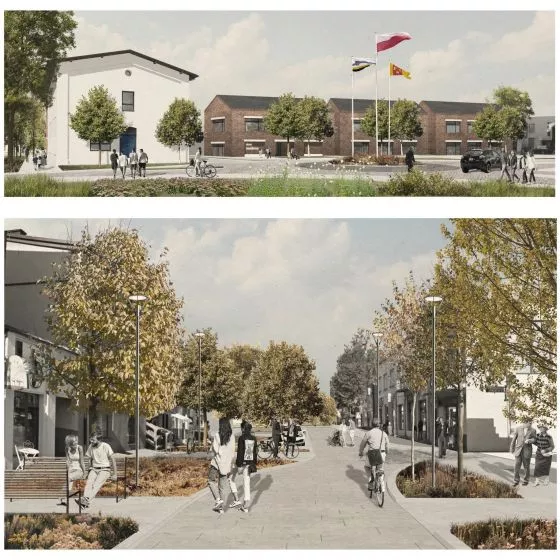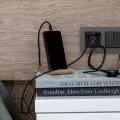questions from chat users
Agnieszka Krawczyk: Is it possible to find a "knowledge base" of such traditional solutions somewhere? As an ethnologist, I don't associate any single study, only scattered ones about regional construction. But maybe architects have something like that?
CENTRALA: We do not know of such a study, and it would be very valuable to compile a bibliography or even develop a compendium of traditional solutions for different Polish climate zones, which could define "new regions." If someone would like to undertake such a task, we would be happy to get involved.
CENTRALA talked about designing discomfort
Photo: Piotr Malec/OEES
Katarzyna Mokrzycka: What does the cooperation of architects-visionaries with local governments look like? How should it be organized systemically? Introduce mandatory consultations? Organize meetings with residents?
CENTRAL: There is no system. In Warsaw, we have the ZODIAK Warsaw Architecture Pavilion, where we hold lectures, exhibitions - on the occasion of such meetings we talk to people working in local government, albeit informally. We also have good contact with activists who popularize these recognitions of ours more widely. E.g., the concept of WETSCAPE was described by Jan Mencwel in his new book titled. "Betonosis." We hope that it will bring the concept of the soaking city to local government officials in various cities.
Agnieszka Krawczyk: Where can you see this refrigerator?
CENTRAL: The spatial trellis is located in Walbrzych, in one of the courtyards near the Collegiate Church. The dugout can be found in housing estates in Kharkiv.
Anonin participant: We feel more and more responsibility, investor awareness is increasing, but considering that the construction industry is responsible for 28% of all carbon emissions, we should actually stop building. Building is an act of environmental violence. More than 6 billion square meters of new buildings are built every year. That's about 1.2 million buildings of 5,000 square meters. Do you see any chance of lowering these ratios?
CENTRAL: We agree - build as little as possible, convert as much as possible from what is already standing. An opportunity for change would be so-called passports of building materials, describing how much "embedded energy" was used in their creation, transportation and how much is needed for their future recycling or reuse. The challenge is to show the hidden environmental costs of newdevelopments, the broader energy perspective in which we should see new developments, not just over their lifetime.
Why do architects contribute to climate change?
Such an interesting meeting was also followed by an exciting skirmish between architects Robert Konieczny of KWK PROMES and Bartlomiej Kisielewski of Horizone Studio. They tried to answer the question posed by the organizers - Why do architects contribute to climate change? Together they concluded that the blame lies on the shoulders of all of us, and not only designers contribute to climate change.
Robert Konieczny's skirmish with Bartłomiej Kisielewski
Photo: Dobrawa Bies © A&B
Robert Konieczny said:
The earth is one big battery that is depleting, and it is happening too fast. Our actions should slow down this process. Everything is in our hands.
Bartlomiej Kisielewski pointed out that in Poland the demand for housing is about 3 million units, so we need to think about how to build wisely. Architects agreed that their profession is a service, but their mission is to carry the torch of education and choose materials wisely.
green me!
The topic of adapting cities to climate change was also considered in an in-depth session led by Dr. Krzysztof Ingarden of Ingarden & Ewý. Invited guests Jacek Ławrecki - Director of Communications Poland and the Baltics, Agnieszka Kalinowska-Sołtys - Vice President of Environment and Climate Protection at SARP, Kacper Kępiński - NIAiU and Aldo Vargas-Tetmajer - URBACT National Point Coordinator discussed the topic of design responsibility, energy plus buildings and building priorities. Agnieszka Kalinowska-Sołtys stressed that the public's mindset should be changed - it is not garbage incinerators that negatively affect the environment, but private homes. She also spoke about the life cycle of buildings and attempts to convince investors to use sustainable, ecological materials.
Kacper Kepinski, on screen Piotr Urbanowicz and Krzysztof Ingarden
Photo: Dobrawa Bies © A&B
Kacper Kepinski argued in favor of point-scoring measures and about asking ourselves about priorities. Is public space only to serve the development of consumption? Are environmental issues the most important now? He stressed that it is not only the visual aspects, but precisely the environmental aspects that are important in a city, e.g. a plaza can be a polder to level extreme weather events. We must remember that a city is a complex ecosystem.
Prof. Hausner spoke about the great importance of imagination
photo: Łukasz Popielarczyk/ OEES
imagination and openness
After so many and exciting events, there was nothing left to do but for Prof. Jerzy Hausner to sum up the congress. Clad in a golden costume from Pawel Althamer, he stressed that imagination is necessary to constantly open the social space-time. To open it to the community leaving room for subjectivity and individuality. The chairman of the Program Council wished everyone to encounter people on their way who are different, but how interesting! Recently, Prof. Hausner published a report entitled. "The State and Us. TheEight Deadly Sins of the Republic," which you can read in full here.
We are already inviting you to next year's OEES and remind you that all registered users will receive access to the congress recordings this December. Become a positivist!









































































